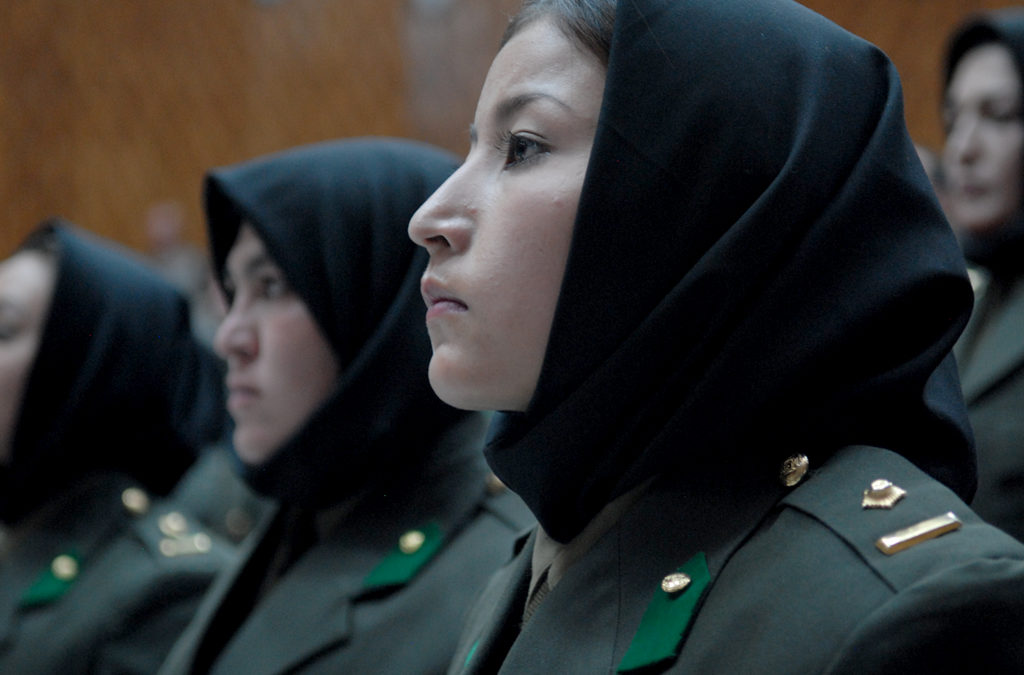In the first 15 years of the United Nations’ post-9/11 counterterrorism program, gender issues were hardly mentioned. This, despite the clearly stated intention of violent extremists and terrorist groups to suppress gender equality, women’s rights, girls’ education, and women’s participation in public and political life. A string of attacks on girls’ schools in Pakistan; a brutal regime of enforced dress codes and behaviors in the so-called Islamic State; kidnapping and forced conversions of girls in Nigeria – these and other attacks highlighted the deliberate targeting of women and girls and were indications of the extremists’ war on the very notion of gender equality.
At the same time, there has also been greater focus on women’s participation in terrorism, either as ideologues, perpetrators, or enablers.[1] In some instances, structural inequalities have left women more vulnerable to manipulation and abuse by terrorist groups, where the categories of victim and perpetrator might overlap.[2]
Eventually, the UN Security Council adopted Resolution 2242 (2015), which calls for a greater convergence of the women, peace, and security agenda and counterterrorism efforts, and facilitates greater interaction between UN Women and international counterterrorism practitioners.[3] This was a significant advance over the previous relegation of gender to “softer” issues of prevention. Gender issues could now be integrated into more operational and tactical measures relating to interdiction and pursuit.
However, this greater attention to gender in counterterrorism is not without controversy. Several women’s groups and civil society organizations have highlighted the risks of securitization and instrumentalization, fearing that funding for women’s rights and development issues will be diverted to militarized approaches.[4]
A major institutional challenge is that much of the counterterrorism assistance agenda remains centered on partnerships and capacity building with law enforcement and military actors. In many instances, women still have limited access to these sectors, which also reduces their opportunities to be present in decision-making discussions on counterterrorism approaches, or to influence tactical decisions which may have a differential impact on women and girls. The gendered dimension of the “hard security” aspects of counterterrorism remain under-discussed.
A larger conceptual challenge is the entrenched stereotype of women as victims, with little or no agency. As a consequence, the work done by women as partners in prevention, as mediators, and as community organizers challenging terrorist narratives, remains under-appreciated and under-funded. In addition, in some instances, counterterrorism financing restrictions have become an impediment to women’s groups accessing financial services and support.[5]
Security Council Resolution 2242 played an important role in creating an environment for policymakers and practitioners to interact more concretely on integrating the agenda of women, peace and security with UN efforts to counter terrorism and prevent violent extremism.[6] However, as with all resolutions, the proof of the pudding is in the eating—in this case, in the effective implementation of the resolution’s measures. In some instances, the resolution has played a critical role in allowing experts, who had previously not interacted, to come together in both formal and informal processes to raise important concerns and challenges to some of the prevailing policies and gender misconceptions.[7] It has created an opening for a tremendous amount of scholarship and expertise that has emerged over the past decade, building on the extensive previous research on countering violent extremism.[8]
The risk is that talking about gender and counterterrorism has become a box-ticking exercise, with plenty of conference sessions on the topic, but no significant shift in counterterrorism programs and funding towards addressing gender issues. Moreover, there remains little appreciation that a focus on gender and women’s roles are not necessarily synonymous, as highlighted by the gendered nature of ISIS’ recruitment narratives aimed at young men, exploiting stereotypes about male roles and interests. While progress has been made in shining a spotlight on the importance of gendered dimensions of terrorism and counterterrorism, there is still much to do to ensure that this issue is meaningfully integrated in policy and practice.
Naureen Chowdhury Fink is the Executive Director of The Soufan Center. She previously served as the Senior Policy Adviser on Counterterrorism and Sanctions at the United Kingdom’s Mission to the United Nations and as policy specialist with UN Women and the UN Counter-Terrorism Executive Directorate (CTED), with a focus on gender and counter-terrorism issues. Before joining the United Nations, she was head of research and analysis for the Global Center on Cooperative Security.
[1] See for example Liam Duffy, “Western Foreign Fighters and the Yazidi Genocide.” Counter-Extremism Project, March 2021: https://www.counterextremism.com/sites/default/files/Western%20Foreign%20Fighters%20and%20the%20Yazidi%20Genocide%20Report%2016%20March%202021.pdf. Also, The Soufan Center, “Terrorism and Counterterrorism in Southeast Asia: Emerging Trends and Dynamics.” June 2021: https://thesoufancenter.org/wp-content/uploads/2021/06/TSC-Report_Terrorism-and-Counterterroris
[2]Jayne Huckerby, “When Terrorists Traffic Their Recruits,” Just Security: https://www.justsecurity.org/75343/when-terrorists-traffic-their-recruits/
[3]United Nations (UN) Security Council Resolution 2242 (2015). Available at: http://unscr.com/en/resolutions/doc/2242
[4]“A Course Correction for the Women, Peace and Security Agenda.” International Crisis Group, Briefing No. 5, 9 December 2020. https://www.crisisgroup.org/global/b05-course-correction-women-peace-and-security-agenda
[5]Duke Law International Human Rights Clinic and Women Peacemakers Program, “Tightening the Purse Strings: What Countering Terrorism Financing Costs Gender Equality and Security” (2017). https://web.law.duke.edu/sites/default/files/humanrights/tighteningpursestrings.pdf
[6]United Nations Security Council Counter-terrorism Committee Executive Directorate (CTED). “CTED Trends Tracker: Integrating gender into counter-terrorism and CVE Resolution 2242 (2015) – five years on.” 2020. https://www.un.org/securitycouncil/ctc/sites/www.un.org.securitycouncil.ctc/files/files/documents/2020/Dec/cted_trends_tracker_2242_anniversary.pdf
[7]Chowdhury Fink, Naureen and Alison Davidian. “Complementarity and Convergence?: Women, Peace and Security and Counterterrorism.” In The Oxford Handbook of Gender and Conflict, eds. Fionnuala Ni Aolain, Naomi Cahn, Dina Francesca Haynes, and Nahla Valji: December 2017. DOI: 10.1093/oxfordhb/9780199300983.013.13
[8]See for example: Jessica Davis, Women in Modern Terrorism: From Liberation to Global Jihad in the Islamic State. Lanham, MD, Rowman and Littlefield, 2015. ISBN: 9781442274976; Joana Cook, A Woman’s Place: Us Counterterrorism Since 9/11. Oxford University Press, 2020. ISBN-13: 978-0197506554; Audrey Alexander (ed.), “Perspectives on the Future of Women, Gender, and Violent Extremism.” The George Washington University Program on Extremism, February 2019. https://extremism.gwu.edu/sites/g/files/zaxdzs2191/f/Perspectives%20on%20the%20Future%20of%20Women%2C%20Gender%20and%20Violent%20Extremism.pdf





